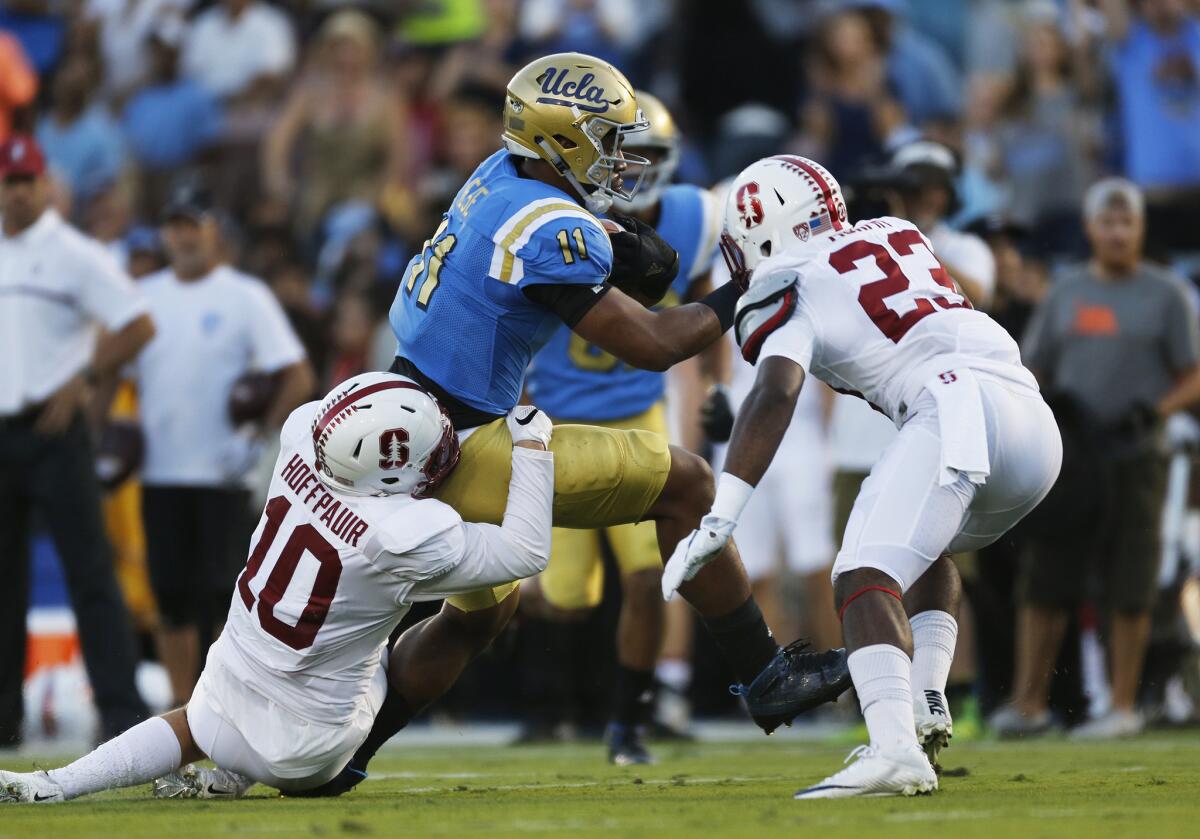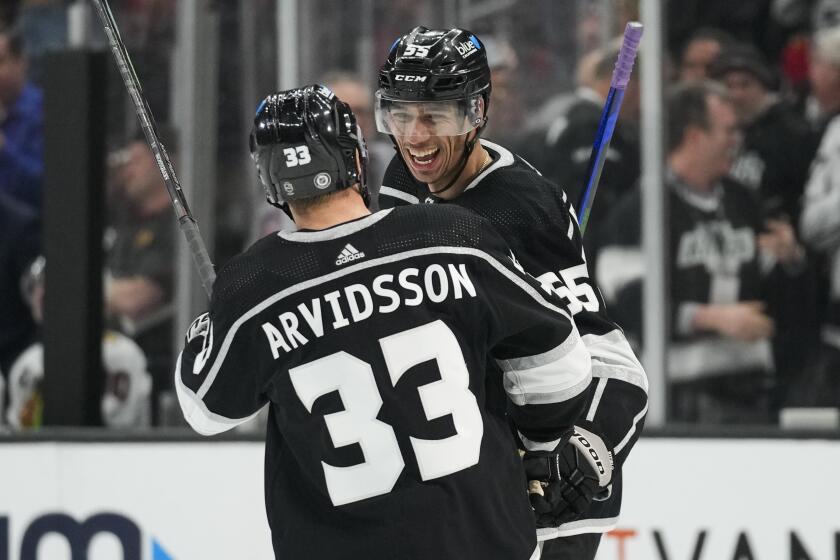NCAA’s effort to curtail ‘targeting’ practice by tacklers hasn’t been 100% effective

It was the sort of play that college football is trying to eliminate. At least, that’s how it looked at first glance.
A Stanford receiver caught the ball over the middle and was nailed, helmet-to-helmet, by a UCLA defensive back. The force of impact sent Francis Owusu spinning through the air, leaving him face-down on the turf.
As medical personnel scrambled onto the field, Stanford Coach David Shaw hollered at officials.
“One player had the ball, another player initiated contact with his helmet,” Shaw said later. “That should be a penalty.”
There was no flag. And the replay booth — now authorized to make such calls — saw no reason to step in.
If nothing else, the collision at the Rose Bowl last Saturday proved that, despite the NCAA’s renewed emphasis, getting rid of “forcible contact” — otherwise known as targeting — might not be so simple.
Certainly the stakes are high.
Concussions have become almost as commonplace in football as sprained ankles. So have stories about former players struggling with the devastating effects of brain trauma.
If things don’t improve, America’s most popular sport could eventually go the way of boxing — fewer and fewer parents letting their kids play, the best young talent turning elsewhere.
Yet, through the first month of the season, the debate continues over targeting rules and how they are enforced.
“It is subtle,” Steve Shaw, coordinator of referees for the Southeastern Conference, told reporters. “So these are all very difficult plays.”
The NCAA rule book breaks the issue into two parts. Rule 9-1-3 prohibits forcible contact with the crown of the helmet. Rule 9-1-4 prohibits making forcible contact to the head or neck of a defenseless player.
“It’s our most important call,” Bill Carollo, head of Big Ten Conference officials, said before the season. “It’s our most severe penalty.”
In addition to walking off 15 yards, officials automatically eject the guilty player. If the foul takes place in the second half, he must sit out the first half of the next game.
As a matter of practice, officials are supposed to err on the side of safety. Shaw of the SEC put it this way: “If it’s close, we expect our guys to get the marker on the ground.”
Taking it a step further, the NCAA gave that extra authority to replay officials, who can now stop a game to assess any “obvious and egregious” penalties missed in the blur of the moment.
The rules might seem clear, but coaches have expressed concern about inconsistent enforcement.
“There’s some gray area in there,” said Minnesota Coach Tracy Claeys, whose team was hit with three targeting penalties in its season opener against Oregon State.
Brigham Young Coach Kalani Sitake charged onto the field after two of his players were ejected for targeting on back-to-back plays against Utah. Some thought the calls were excessive.
In the Stanford-UCLA game, television commentators believed that officials had erred in the opposite direction.
As the play unfolded, UCLA defensive back Tahaan Goodman clearly lowered his head but may have struck Owusu with the side of his helmet, not the crown. The Cardinal receiver had taken several steps with the ball, so did not qualify as defenseless.
The Bruins had been on the receiving end of a similar hit two weeks earlier, with receiver Eldridge Massington taking a shot to the head from a Nevada Las Vegas defensive back. In that case, the defender was ejected.
Stanford’s Shaw remains upset about the lack of a call on the Owusu play, arguing that rule-book nuances should not prevent officials from making the game “as safe as we can make it.”
Watch old film of Dick Butkus or Ronnie Lott as they launched themselves through the air, using their shoulder pads and chests to hammer ballcarriers. Football has waged a campaign to return to those days, with posters in college and NFL locker rooms reminding teams about safer tackling techniques.
“See what you hit” has become an axiom, even if it is a bit of a misnomer because officials don’t want players leading with their facemasks, either.
“We’re seeing player behavior change,” the SEC’s Shaw said. “And I think we’re making good progress around targeting.”
There is still a ways to go.
This Friday, when Stanford travels to Washington, Owusu is expected to sit out with lingering effects of a concussion. David Shaw has spoken to Pac-12 officials but declined to comment further, saying “it’s up to the conference to say anything publicly.”
David Coleman, the Pac-12 vice president of officiating, was not made available for an interview. The conference issued a statement Tuesday night, reaffirming the call but stating: “Going forward, and in line with Coach David Shaw’s concerns about this play, we expect additional discussion around the targeting rule during the off-season review process.”
Shaw would like to see some action put behind the NCAA’s emphasis on targeting.
“We should mean it,” he said. “The rules obviously need to be amended, they need to be adjusted.”
david.wharton@latimes.com
Twitter: @LATimesWharton
More to Read
Get our high school sports newsletter
Prep Rally is devoted to the SoCal high school sports experience, bringing you scores, stories and a behind-the-scenes look at what makes prep sports so popular.
You may occasionally receive promotional content from the Los Angeles Times.






